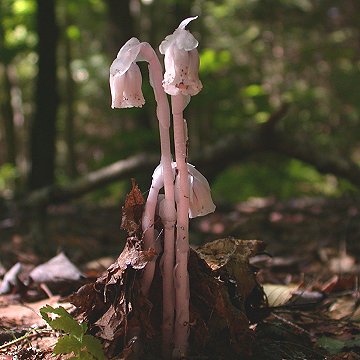

Monotropa uniflora - (image 1 of 6)
Taxonomy
Family: Monotropaceae
Habitat
Rich woods.
Associates
Myco-heterotrophic, parasitizing mycorrhizal fungi associated with trees (Image 4).
Distribution
Western coastal states and most of the US east of the Rockies.
Morphology
Achlorophyllous perennial to 20 cm, solitary or in groups. Stems pearly white, occasionally pink to red. Leaves scale-like. Flowers solitary, nodding, to 16 mm; petals oblong, widest at the tip; anthers transverse, opening by 2 clefts across the top; style short, thick, longer than the ovary; fruit a capsule, becoming erect and blackening when dry, opening from the top downward.
Notes
Flowers June to August
Wetland indicator: Facultative
Obtains energy from fungi in the family Russulaceae, including Russula spp.and Lactarius spp. (Yang and Pfister 2006).
References
Gleason, Henry A. and A. Cronquist. 1991. Manual of Vascular Plants of
Northeastern United States
and Adjacent Canada. Second Ed.
The New York Botanical Garden. Bronx, NY
Swink, F. and G. Wilhelm. 1994. Plants of the Chicago Region.
Indiana Academy of Science. The Morton Arboretum. Lisle, Illinois.
USDA, NRCS. 2002.
The PLANTS Database, Version 3.5 (http://plants.usda.gov).
National Plant Data Center, Baton Rouge, LA 70874-4490 USA.
Yang S and. Pfister DH.
2006. Monotropa uniflora plants of eastern Massachusetts form mycorrhizae with a
diversity of russulacean fungi.
Mycologia, 98(4), 535-540.
|
Michael Hough © 2005 |